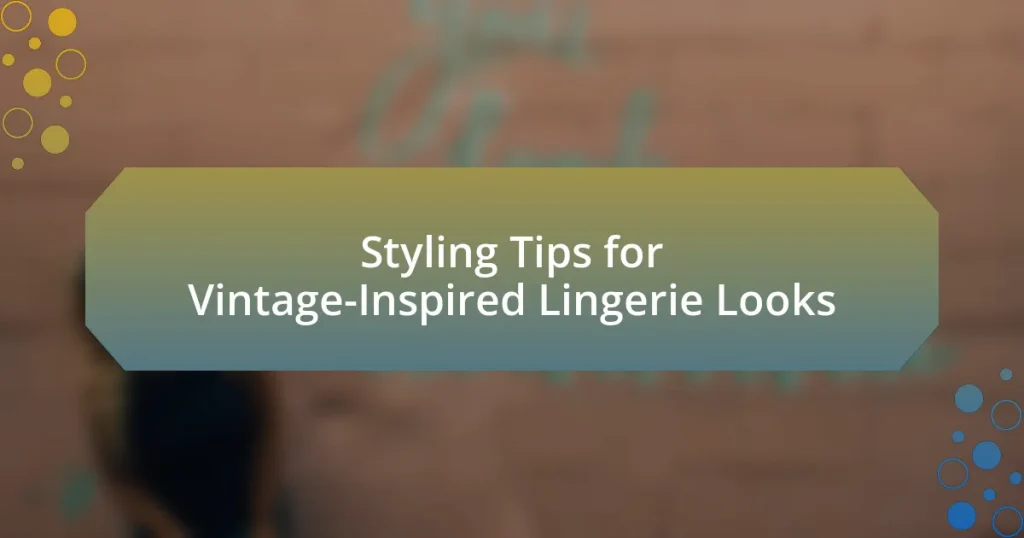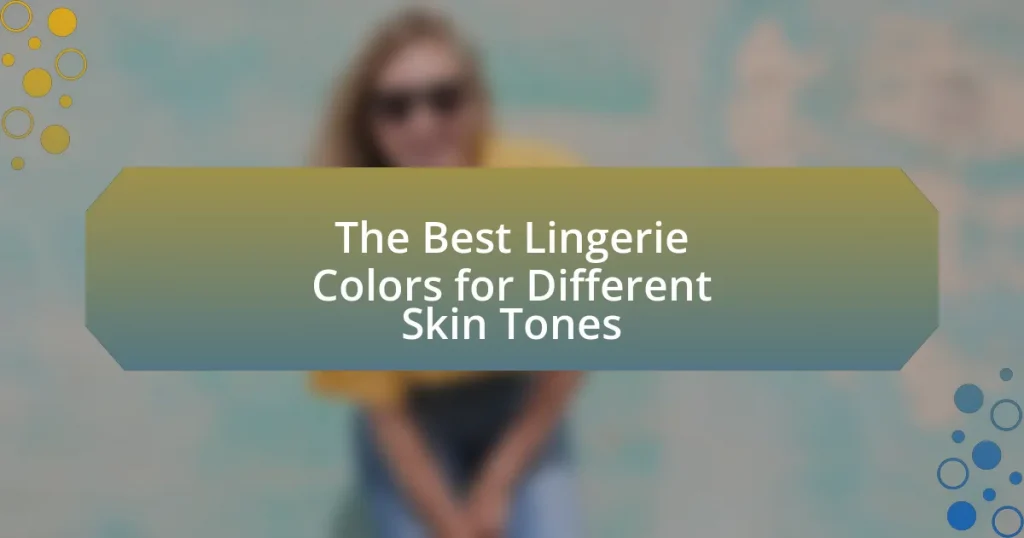The article examines the significant role of lingerie in body positivity movements, highlighting how it promotes self-acceptance and celebrates diverse body types. It discusses the evolution of lingerie in relation to body positivity, emphasizing the impact of brands like Savage X Fenty and Aerie that prioritize inclusivity in their marketing and product offerings. The article also explores historical factors influencing the perception of lingerie, the challenges faced by the industry, and the importance of size inclusivity. Additionally, it addresses how cultural backgrounds shape perceptions of lingerie and outlines future trends in the industry, including the integration of technology and sustainable practices.

What is the Role of Lingerie in Body Positivity Movements?
Lingerie plays a significant role in body positivity movements by promoting self-acceptance and celebrating diverse body types. This intimate apparel empowers individuals to embrace their bodies, regardless of societal beauty standards, by offering styles that cater to various shapes, sizes, and personal preferences. Brands that prioritize inclusivity in their lingerie lines, such as Savage X Fenty, have demonstrated that representation matters; they feature models of different sizes, ethnicities, and gender identities, which helps to challenge traditional notions of beauty. Research indicates that positive body image can be enhanced through clothing choices, including lingerie, as it allows individuals to express their identity and feel confident in their skin.
How has lingerie evolved in the context of body positivity?
Lingerie has evolved significantly in the context of body positivity by embracing diverse body shapes and sizes, moving away from traditional beauty standards. This shift is evidenced by brands like Aerie and Savage X Fenty, which promote inclusivity through campaigns featuring models of various body types, thereby challenging the narrow definitions of beauty. Additionally, the rise of body-positive movements has led to increased consumer demand for lingerie that celebrates individuality, resulting in a broader range of sizes and styles available in the market. This evolution reflects a cultural shift towards acceptance and empowerment, as lingerie is now marketed not just as an item of clothing, but as a means of self-expression and confidence for all body types.
What historical factors contributed to the current perception of lingerie?
The current perception of lingerie has been shaped by several historical factors, including the evolution of women’s fashion, societal attitudes towards femininity, and the impact of feminist movements. In the early 20th century, lingerie transitioned from restrictive corsets to more comfortable undergarments, reflecting changing views on women’s roles and bodily autonomy. The introduction of the bra in the 1910s, popularized by figures like Mary Phelps Jacob, marked a significant shift towards practicality and comfort, aligning with the burgeoning women’s rights movement. Additionally, the sexual liberation of the 1960s and 1970s further transformed lingerie into a symbol of empowerment and self-expression, as women began to embrace their bodies and challenge traditional beauty standards. These historical developments collectively contributed to the modern perception of lingerie as both a functional garment and a tool for body positivity, celebrating diverse body types and personal choice.
How do modern lingerie brands align with body positivity ideals?
Modern lingerie brands align with body positivity ideals by promoting inclusivity and diversity in their sizing, marketing, and product offerings. Brands like Savage X Fenty and Aerie have set industry standards by featuring models of various body types, ethnicities, and sizes in their campaigns, which challenges traditional beauty norms. For instance, Savage X Fenty’s runway shows include a wide range of body shapes, emphasizing that lingerie is for everyone, not just a select few. Additionally, Aerie’s “Aerie Real” campaign has committed to not retouching photos, reinforcing authenticity and self-acceptance. These practices not only reflect a commitment to body positivity but also resonate with consumers, as evidenced by Aerie’s 20% sales increase following their campaign launch.
Why is lingerie significant in promoting body positivity?
Lingerie is significant in promoting body positivity because it empowers individuals to embrace their bodies in all shapes and sizes. By offering a diverse range of styles, sizes, and representations, lingerie brands challenge traditional beauty standards and encourage self-acceptance. For instance, campaigns by brands like Aerie and Savage X Fenty have showcased models of various body types, which has been linked to increased self-esteem among consumers. Research indicates that exposure to diverse body representations in media can lead to improved body image and reduced body dissatisfaction, reinforcing the role of lingerie in fostering a positive relationship with one’s body.
How does lingerie influence self-image and confidence?
Lingerie significantly influences self-image and confidence by enhancing body positivity and personal empowerment. When individuals wear lingerie that fits well and aligns with their personal style, they often experience an increase in self-esteem and a more positive body image. Research indicates that wearing lingerie can lead to feelings of attractiveness and desirability, which in turn boosts confidence levels. A study published in the Journal of Consumer Research found that individuals who engage in self-enhancing behaviors, such as wearing appealing lingerie, report higher self-worth and satisfaction with their bodies. This connection between lingerie and self-image underscores its role in promoting body positivity and encouraging individuals to embrace their unique forms.
What messages do lingerie campaigns convey about body diversity?
Lingerie campaigns convey messages of body diversity by showcasing models of various sizes, shapes, and ethnic backgrounds, promoting inclusivity and acceptance. These campaigns often feature real women rather than traditional, narrow beauty standards, which helps to challenge societal norms and encourages consumers to embrace their own bodies. For instance, brands like Aerie and Savage X Fenty have gained recognition for their commitment to body positivity, using unretouched images and a wide range of sizes to reflect the diversity of their customer base. This approach not only resonates with a broader audience but also fosters a sense of empowerment and self-acceptance among individuals who may feel marginalized by conventional beauty ideals.
What challenges does the lingerie industry face regarding body positivity?
The lingerie industry faces significant challenges regarding body positivity, primarily due to the persistent promotion of narrow beauty standards. These standards often exclude diverse body types, leading to a lack of representation in marketing and product offerings. For instance, a study by the University of Kent found that 70% of women feel underrepresented in lingerie advertisements, which can negatively impact their self-esteem and body image. Additionally, the industry’s focus on idealized body shapes can perpetuate harmful stereotypes and discourage inclusivity, making it difficult for brands to authentically embrace body positivity.
How do societal beauty standards impact lingerie marketing?
Societal beauty standards significantly influence lingerie marketing by dictating the ideal body types and aesthetics that brands promote. These standards often prioritize thinness, youth, and specific physical features, leading lingerie companies to create advertising campaigns and product lines that reflect these ideals. For instance, a study published in the Journal of Consumer Research found that brands using models who conform to conventional beauty standards tend to attract more consumer attention and sales. This reliance on narrow beauty ideals can marginalize diverse body types and perpetuate unrealistic expectations, impacting consumer self-esteem and body image. Consequently, lingerie marketing strategies are often aligned with prevailing societal norms, which can either reinforce or challenge these standards depending on the brand’s approach.
What are the criticisms of lingerie brands in the body positivity movement?
Lingerie brands face criticisms in the body positivity movement for promoting unrealistic beauty standards and failing to represent diverse body types. Critics argue that many brands continue to use thin models and airbrush images, which undermines the movement’s goal of inclusivity and acceptance of all body shapes. For instance, a study by the University of California found that advertising featuring diverse body types positively influences body image among consumers, highlighting the gap in representation by mainstream lingerie brands. Additionally, some brands have been accused of co-opting body positivity for marketing purposes without making genuine efforts to support the movement, leading to accusations of hypocrisy.

How do different demographics engage with lingerie in body positivity?
Different demographics engage with lingerie in body positivity by embracing diverse body types and promoting self-acceptance through inclusive marketing and product offerings. For instance, brands like Aerie and Savage X Fenty have successfully targeted a wide range of consumers by featuring models of various sizes, ethnicities, and gender identities, which fosters a sense of belonging and empowerment. Research indicates that 67% of women feel more confident when they see diverse body representations in lingerie advertising, highlighting the impact of inclusive practices on consumer engagement. This engagement not only enhances individual self-esteem but also contributes to a broader cultural shift towards body positivity across different age groups and backgrounds.
What role does size inclusivity play in lingerie offerings?
Size inclusivity in lingerie offerings plays a crucial role in promoting body positivity and ensuring that all individuals feel represented and valued. By providing a diverse range of sizes, lingerie brands cater to a broader audience, allowing people of different body types to find products that fit comfortably and enhance their self-esteem. Research indicates that brands that embrace size inclusivity can significantly impact consumer perception and loyalty; for instance, a study by the University of Kent found that 67% of consumers are more likely to purchase from brands that offer a wider size range. This inclusivity not only fosters a sense of belonging but also challenges traditional beauty standards, encouraging a more accepting view of diverse body shapes.
How do plus-size lingerie options contribute to body positivity?
Plus-size lingerie options contribute to body positivity by promoting inclusivity and self-acceptance among individuals of all body types. These options challenge societal beauty standards that often marginalize larger bodies, allowing individuals to embrace their curves and feel confident in their skin. Research indicates that representation in fashion, including lingerie, positively impacts self-esteem; for instance, a study published in the Journal of Consumer Research found that diverse body representation in advertising leads to increased body satisfaction among consumers. By offering stylish and comfortable choices, plus-size lingerie empowers individuals to celebrate their bodies, fostering a culture of acceptance and love for all shapes and sizes.
What are the experiences of diverse body types in lingerie shopping?
Diverse body types experience lingerie shopping with varying degrees of accessibility, representation, and satisfaction. Many individuals with non-standard body shapes often face challenges such as limited size ranges, inadequate representation in marketing, and a lack of options that cater to their specific needs. Research indicates that 67% of women feel that lingerie brands do not adequately represent their body types, leading to feelings of exclusion and frustration during the shopping process. Additionally, the rise of body positivity movements has prompted some brands to expand their size offerings and include models of different shapes and sizes, which has improved the shopping experience for many. However, despite these advancements, significant gaps remain, as many retailers still prioritize a narrow range of body types in their product lines and advertising.
How does cultural background influence perceptions of lingerie?
Cultural background significantly influences perceptions of lingerie by shaping attitudes toward body image, modesty, and sexuality. For instance, in Western cultures, lingerie is often viewed as a symbol of empowerment and self-expression, promoting body positivity and individual choice. Conversely, in many conservative cultures, lingerie may be associated with shame or viewed as inappropriate, emphasizing modesty and traditional values. Research indicates that cultural norms dictate the acceptability of lingerie, with studies showing that women from collectivist societies often prioritize societal expectations over personal preferences in their lingerie choices. This demonstrates how cultural context directly impacts the interpretation and significance of lingerie in relation to body positivity movements.
What cultural differences exist in lingerie marketing and body positivity?
Cultural differences in lingerie marketing and body positivity are significant, as they reflect varying societal norms and values regarding body image. In Western cultures, lingerie marketing often emphasizes sexual empowerment and individualism, promoting diverse body types through campaigns featuring models of various sizes, as seen in brands like Aerie and Savage X Fenty. Conversely, in many Asian cultures, lingerie marketing may focus on traditional ideals of femininity and modesty, often portraying a more conservative image that aligns with cultural expectations, such as in the marketing strategies of brands like Wacoal in Japan. These differences highlight how cultural contexts shape perceptions of body positivity, influencing both consumer behavior and brand messaging in the lingerie industry.
How do different cultures celebrate body diversity through lingerie?
Different cultures celebrate body diversity through lingerie by embracing a wide range of body types and promoting inclusivity in their designs and marketing. For instance, in the United States, brands like Savage X Fenty have revolutionized the lingerie industry by featuring models of various sizes, ethnicities, and gender identities, thereby challenging traditional beauty standards. Similarly, in Brazil, the celebration of diverse body shapes is evident in the popularity of lingerie that highlights curves, reflecting the cultural appreciation for body positivity. In addition, many Asian cultures incorporate traditional garments that celebrate body diversity, such as the Japanese kimono, which is adapted into modern lingerie styles that honor various body shapes. These practices demonstrate a growing recognition of body diversity across different cultures, supported by movements advocating for representation and acceptance in the fashion industry.

What are the future trends of lingerie in body positivity movements?
The future trends of lingerie in body positivity movements will focus on inclusivity, diverse sizing, and sustainable materials. Brands are increasingly expanding their size ranges to accommodate all body types, reflecting the demand for representation and acceptance in the fashion industry. For instance, companies like Savage X Fenty have set a precedent by offering sizes from XS to 3X, promoting the idea that lingerie should be accessible to everyone. Additionally, there is a growing emphasis on using eco-friendly materials, as consumers become more conscious of environmental impacts, aligning with the values of body positivity that advocate for holistic well-being. This shift is supported by market research indicating that 67% of consumers prefer brands that prioritize sustainability.
How are technology and innovation shaping the lingerie industry?
Technology and innovation are significantly shaping the lingerie industry by enhancing product design, improving fit, and promoting inclusivity. Advanced materials, such as moisture-wicking fabrics and seamless construction techniques, allow for greater comfort and functionality, catering to diverse body types. Additionally, 3D body scanning technology enables brands to create personalized sizing, ensuring a better fit for consumers. The integration of smart textiles, which can monitor body temperature and provide support, further exemplifies innovation in this sector. According to a report by Grand View Research, the global lingerie market is projected to reach $78.66 billion by 2025, driven in part by these technological advancements that meet evolving consumer demands for comfort and body positivity.
What role does sustainable fashion play in body positivity?
Sustainable fashion promotes body positivity by encouraging inclusivity and self-acceptance through diverse sizing and ethical production practices. This approach challenges traditional beauty standards by offering clothing that fits a wider range of body types, thus fostering a sense of belonging and confidence among consumers. Research indicates that brands committed to sustainability often prioritize body diversity, which can positively influence self-image and acceptance. For instance, a study published in the Journal of Fashion Marketing and Management highlights that consumers are more likely to feel empowered when they see their body type represented in sustainable fashion campaigns.
How are brands using social media to promote body positivity through lingerie?
Brands are using social media to promote body positivity through lingerie by showcasing diverse body types and encouraging self-acceptance. For instance, many lingerie brands feature models of various sizes, shapes, and ethnicities in their campaigns, which helps to challenge traditional beauty standards. A notable example is Aerie, which has gained recognition for its #AerieREAL campaign that promotes unretouched images of models, leading to a 20% increase in sales after its launch. Additionally, brands engage with their audience by sharing user-generated content, allowing customers to share their own body-positive stories and experiences, further fostering a community of acceptance and support. This strategy not only enhances brand loyalty but also aligns with the growing consumer demand for inclusivity and representation in fashion.
What practical tips can consumers consider when choosing lingerie for body positivity?
Consumers should prioritize comfort and fit when choosing lingerie for body positivity. Selecting lingerie that fits well enhances body confidence and promotes a positive self-image. Additionally, opting for diverse styles and sizes allows individuals to express their unique body shapes and preferences, reinforcing the idea that all bodies are beautiful. Research indicates that wearing well-fitting lingerie can significantly improve self-esteem and body image, as noted in a study published in the Journal of Fashion Marketing and Management, which highlights the psychological benefits of clothing choices on self-perception.
How can individuals find lingerie that enhances their body confidence?
Individuals can find lingerie that enhances their body confidence by selecting styles that fit well and flatter their unique body shapes. Research indicates that wearing well-fitted lingerie can significantly improve self-esteem and body image, as it provides comfort and support. For example, a study published in the Journal of Fashion Marketing and Management found that women who wear lingerie that aligns with their body type report higher levels of body satisfaction. Additionally, exploring brands that prioritize inclusivity and offer a wide range of sizes can help individuals feel represented and confident in their choices.
What should consumers look for in brands that support body positivity?
Consumers should look for brands that promote inclusivity and diversity in their marketing and product offerings. Brands that support body positivity often feature models of various sizes, shapes, and backgrounds, reflecting a realistic representation of all body types. Additionally, these brands typically emphasize positive messaging around self-acceptance and confidence, rather than perpetuating narrow beauty standards. Research indicates that brands that embrace body positivity can enhance consumer loyalty and trust, as seen in studies showing that 67% of consumers prefer brands that celebrate diversity in their advertising.















